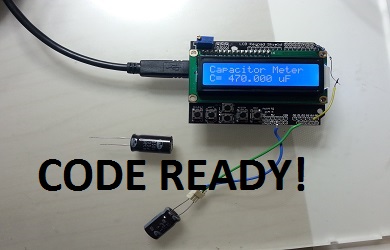Lesson 14 Arduino Capacitor Meter Code
// By Roee Bloch Capacitor-Meter
//All right Reserved
// Copyright (c) 2015 All Right Reserved, http://www.electronics-freak.com
//
// This source is subject to the Roee Bloch License.
// Please see the License.txt file for more information.
// All other rights reserved.
//
// THIS CODE AND INFORMATION ARE PROVIDED "AS IS" WITHOUT WARRANTY OF ANY
// KIND, EITHER EXPRESSED OR IMPLIED, INCLUDING BUT NOT LIMITED TO THE
// IMPLIED WARRANTIES OF MERCHANTABILITY AND/OR FITNESS FOR A
// PARTICULAR PURPOSE.
//
// </copyright>
// <author>Roee Bloch</author>
// <email>roeebloch@walla.co.il</email>
// <date>June 2015</date>
/*
Part of the CODE is LCD Taken from:
Library originally added 18 Apr 2008
by David A. Mellis
library modified 5 Jul 2009
by Limor Fried (http://www.ladyada.net)
example added 9 Jul 2009
by Tom Igoe
modified 22 Nov 2010
by Tom Igoe
Formulas in use are:
R(measured) = (RKnown(VCC-Vmeasured))/VMeasured
V(measured) = ((ADC VALUE)/1024)*VCC
Ciruit is this:
Connect CRL Pin (Digital pin 2)-> 1K Resistor -> Analog in 1 -> Capacitor to measure Positive || -> Negative capacitor pin to GND
*/
#include <LiquidCrystal.h>
#define analog_in 1 // define analog input pin in use
#define digital_ctrl 2 // digital pin control that will charge and discharge capacitor
#define VCC 5 //define VCC for calculation
#define R_known 1000 // define Reference resistor in use, I have found this value is very good to many measurements, but if you have another resistor you may change this value according
#define display_time 5 // how many seconds show the value before remeasuring
float V_measured, limit, calc ;
int analog_read;
char flag = 0, flag2 = 0;
int t1, t2, t3, t4; //timers to use
// initialize the library with the numbers of the interface pins
LiquidCrystal lcd(8, 9, 4, 5, 6, 7);
void setup()
{
Serial.begin(57600);
Serial.println("Starting");
pinMode(digital_ctrl, OUTPUT);
lcd.begin(16, 2);
lcd.print("Capacitor Meter ");
digitalWrite(digital_ctrl, LOW); // starting discharge
}
void loop()
{
flag = 0;
digitalWrite(digital_ctrl, LOW);
mycalc();
while (V_measured > 0.1)
{
digitalWrite(digital_ctrl, LOW); // starting discharge
Serial.println("Discharging Capacitor");
lcd.print("Disch. Capacitor");
lcd.setCursor(0, 1);
Serial.println("Please wait....");
mycalc();
}
// discharge complete
myclear();
lcd.setCursor(0, 1);
lcd.print("Charging now..");
digitalWrite(digital_ctrl, HIGH); // starting to charge capacitor
limit = 0.6321 * VCC; // value of 1 TAU = R*C
t1 = millis();
mycalc();
while (V_measured < limit)
{ // reading again and waiting to charge for 63%
mycalc();
} // charge complete
t2 = millis();
myclear();
lcd.setCursor(0, 1);
Serial.println("COMPLETE");
lcd.print("COMPLETE");
calc = float(t2 - t1) / float(R_known);
if (calc < 1)
{
calc = 1000 * calc;
flag = 1;
}
Serial.println("Capacitor is:");
if (flag == 1)
{
Serial.print(float(calc), 3);
Serial.println(" uF");
myclear();
lcd.setCursor(0, 1);
lcd.print("C= ");
lcd.print(float(calc), 3);
lcd.print(" uF");
delay(display_time*1000);
}
else
{
Serial.println(float(calc), 6);
Serial.print(float(calc), 3);
Serial.println(" mF");
myclear();
lcd.setCursor(0, 1);
lcd.print("C= ");
lcd.print(float(calc), 3);
lcd.print(" mF");
delay(display_time*1000);
}
Serial.println(t2); //for debug on serial port
Serial.println(t1); //for debug on serial port
delay(2000); // delay before next reading
mycalc();
t3 = millis();
while (V_measured > VCC - 0.1) // not inserted new capacitor yet
{
mycalc();
t4 = millis();
if (flag2 == 0) {
Serial.println("waiting");
flag2 = 1;
}
if ((t4 - t3) > (display_time*1000)) // after display_time seconds testing again
{
Serial.println("Testing Again");
lcd.setCursor(0, 1);
lcd.print("Testing Again");
delay(1000);
break;
}
}
flag2 = 0;
}
void myprint(float x, String param)
{
int myprint;
myprint = (x);
Serial.print(param);
Serial.print(" is:");
Serial.println(myprint);
}
void myclear() // clear all second line
{
lcd.setCursor(0, 1);
lcd.print(" ");
}
void mycalc()
{
analog_read = analogRead(analog_in);
V_measured = (analog_read) * VCC; // this is voltage *1024 since we did not divide by 1024
V_measured = V_measured / 1024.0;
}
Video to Theory of this Circuit: https://youtu.be/3kUuhFtO1KM
Video based on this code: lesson-14-arduino-capacitor-meter
| [adsenseyu6] |
Parts for this project are here:
